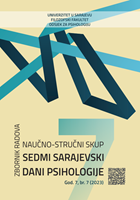Zloupotreba droga, rizična ponašanja i neki aspekti liječenja ovisnika
Drug abuse, risk behavior and some aspects of treatment of addicts
Author(s): Hana Mujkanović, Dario VučenovićSubject(s): Individual Psychology, Behaviorism, Studies in violence and power, Substance abuse and addiction, Health and medicine and law
Published by: Filozofski fakultet Univerziteta u Sarajevu
Keywords: drug abuse; drug addiction; criminal behaviors; risky health behaviors; treatment;
Summary/Abstract: Among the most serious consequences of drug abuse for any society, in addition to economic damage, are also health problems and criminal behavior related to illegal drugs. Accordingly, the general goal of the research was to examine the occurrence of drug abuse (determine the reason for starting drug experimentation, the average age of first taking drugs and the average age of taking the primary drug of addiction, who was the first to find out and expose the drug problem and what type of drug addicts consume ), risky behavior (to determine when criminal activity occurred and the level of risky health behaviors) and some aspects of the treatment of addicts (to determine whether there are differences in the outcome of addiction treatment depending on the type of primary drug of addiction, who referred the addict to treatment, whether he is receiving pharmacotherapy and which dominant treatment facility). The research was conducted on the collected data of 6,858 persons treated for drug abuse in the Republic of Croatia, average age M=38.02 years (SD=10.17). For the purposes of this research, the Pompidou questionnaire was used with basic data on addicts in the treatment program. Of the total number of respondents, 82.7% were men. The results show that the most common reason for experimenting with drugs is the influence of peers or partners (39.6%). The average age of first taking any addictive substance was M=16.22 years (SD=4.09). For the largest number of addicts, the first drug of addiction was cannabinoids (80.3%), while in the largest percentage (70%) heroin was the primary drug of addiction. It was found that 34.6% of addicts broke the law for the first time after they started taking harder addictive substances, and 26% after they started taking lighter addictive substances. Furthermore, 63.9% of addicts took drugs intravenously at one point, whereby the average age of the first intravenous intake was M=21.15 years (SD=4.86). 53.1% of addicts used common utensils for consuming addictive substances. Slightly more than half of addicts (55.5%) personally applied for some form of addiction treatment, and the dominant treatment institution is the service for prevention and outpatient addiction treatment (77.8%). In the end, the outcome of treatment for opiate addiction is somewhat more favorable than for treatment of non-opiate addiction. The obtained results on a practical level could be used to shape guidelines for public policies related to disciplinary measures and criminal procedures. They emphasize the need to involve educational institutions in the primary prevention of drug addiction.
Journal: SARAJEVSKI DANI PSIHOLOGIJE: ZBORNIK RADOVA
- Issue Year: 7/2023
- Issue No: 7
- Page Range: 145-175
- Page Count: 31
- Language: Croatian

